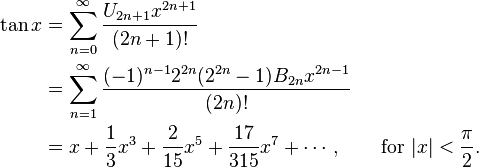Series Definitions
Trigonometric functions are analytic functions. Using only geometry and properties of limits, it can be shown that the derivative of sine is cosine and the derivative of cosine is the negative of sine. (Here, and generally in calculus, all angles are measured in radians; see also the significance of radians below.) One can then use the theory of Taylor series to show that the following identities hold for all real numbers x:
These identities are sometimes taken as the definitions of the sine and cosine function. They are often used as the starting point in a rigorous treatment of trigonometric functions and their applications (e.g., in Fourier series), since the theory of infinite series can be developed, independent of any geometric considerations, from the foundations of the real number system. The differentiability and continuity of these functions are then established from the series definitions alone. The value of π can be defined as the smallest positive number for which sin =0.
Combining these two series gives Euler's formula: cos x + i sin x = eix.
Other series can be found. For the following trigonometric functions:
- Un is the nth up/down number,
- Bn is the nth Bernoulli number, and
- En (below) is the nth Euler number.
Tangent
When this series for the tangent function is expressed in a form in which the denominators are the corresponding factorials, the numerators, called the "tangent numbers", have a combinatorial interpretation: they enumerate alternating permutations of finite sets of odd cardinality.
Cosecant
Secant
When this series for the secant function is expressed in a form in which the denominators are the corresponding factorials, the numerators, called the "secant numbers", have a combinatorial interpretation: they enumerate alternating permutations of finite sets of even cardinality.
Cotangent
From a theorem in complex analysis, there is a unique analytic continuation of this real function to the domain of complex numbers. They have the same Taylor series, and so the trigonometric functions are defined on the complex numbers using the Taylor series above.
There is a series representation as partial fraction expansion where just translated reciprocal functions are summed up, such that the poles of the cotangent function and the reciprocal functions match:
This identity can be proven with the Herglotz trick. By combining the -th with the -th term, it can be expressed as an absolutely convergent series:
Read more about this topic: Trigonometric Functions
Famous quotes containing the words series and/or definitions:
“Through a series of gradual power losses, the modern parent is in danger of losing sight of her own child, as well as her own vision and style. It’s a very big price to pay emotionally. Too bad it’s often accompanied by an equally huge price financially.”
—Sonia Taitz (20th century)
“Lord Byron is an exceedingly interesting person, and as such is it not to be regretted that he is a slave to the vilest and most vulgar prejudices, and as mad as the winds?
There have been many definitions of beauty in art. What is it? Beauty is what the untrained eyes consider abominable.”
—Edmond De Goncourt (1822–1896)






